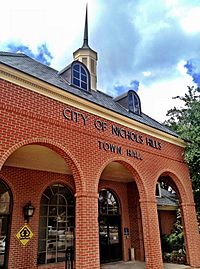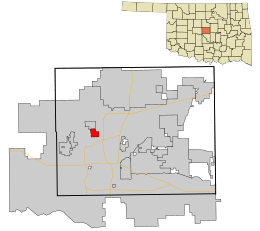Nichols Hills, Oklahoma facts for kids
Quick facts for kids
Nichols Hills, Oklahoma
|
|
|---|---|

City of Nichols Hills Town Hall
|
|

Location in Oklahoma County and the state of Oklahoma.
|
|
| Country | United States |
| State | Oklahoma |
| County | Oklahoma |
| Government | |
| • Type | Council – Manager |
| Area | |
| • Total | 1.98 sq mi (5.13 km2) |
| • Land | 1.97 sq mi (5.11 km2) |
| • Water | 0.01 sq mi (0.03 km2) |
| Elevation | 1,204 ft (367 m) |
| Population
(2020)
|
|
| • Total | 3,870 |
| • Density | 1,962.47/sq mi (757.67/km2) |
| Time zone | UTC-6 (Central (CST)) |
| • Summer (DST) | UTC-5 (CDT) |
| ZIP codes |
73116, 73120
|
| Area code(s) | 405 |
| FIPS code | 40-51800 |
| GNIS feature ID | 2411254 |
| Website | http://www.nicholshills.net |
Nichols Hills is a city in Oklahoma County, Oklahoma, United States. It is part of the larger Oklahoma City metropolitan area. In 2020, the city had a population of 3,870 people. This was a small increase of 4.3% from its population in 2010.
Contents
History of Nichols Hills
The land that is now Nichols Hills covers about 1,280 acres. It was developed by Dr. G.A. Nichols in 1929. He wanted to create a special neighborhood just for homes.
Dr. Nichols was a real estate pioneer in Oklahoma City. Before 1929, he had already developed many other neighborhoods. These included areas like the University, Paseo Arts District, and Lincoln Terrace. He also helped design the city of Nicoma Park.
Why Nichols Hills Was Created
By 1928, Dr. Nichols noticed that oil fields and factories were getting too close to homes in Oklahoma City. He wanted to protect homeowners. So, he planned Nichols Hills with rules to prevent unwanted businesses. He also made sure there were places for shopping nearby.
Dr. Nichols hired a company called Hare and Hare. They were landscape architects from Kansas City, Missouri. They were famous for designing places like the Country Club Plaza. They designed Nichols Hills to follow the natural hills and curves of the land.
Unique Design and Growth
The city has unique curving streets, many named after towns in England. It also has many small and large parks. There were even two golf courses, horse riding paths, and tennis courts. Shopping areas were placed around the edges of the city.
Nichols Hills officially became a city in September 1929. It grew bigger when Dr. Nichols added more land to the city.
Challenges and Success
In the early 1930s, the The Great Depression caused financial problems for Nichols Hills. Many large investors stopped paying their taxes. Nichols Hills asked Oklahoma City to take over the city, but Oklahoma City said no.
This refusal made the citizens of Nichols Hills work together. They started projects to improve the city and raise money. After World War II, many large and fancy homes were built.
By 1950, Oklahoma City began taking over land around Nichols Hills. This included some areas Dr. Nichols had planned for Nichols Hills. Today, Nichols Hills is completely surrounded by Oklahoma City on three sides. It is bordered by The Village to the north.
In 1959, the city created its first official charter. This helped Nichols Hills avoid being taken over by Oklahoma City. Since then, Nichols Hills has kept strict rules about land use and building.
Nichols Hills is known for its high-quality homes. The city also maintains many parks. It is home to the Oklahoma City Golf & Country Club. This club's golf course was designed by Perry Maxwell.
Geography
Nichols Hills covers a total area of about 2.0 square miles (5.1 square kilometers). Most of this area is land, with a very small part being water.
Population and People
| Historical population | |||
|---|---|---|---|
| Census | Pop. | %± | |
| 1940 | 942 | — | |
| 1950 | 2,606 | 176.6% | |
| 1960 | 4,897 | 87.9% | |
| 1970 | 4,478 | −8.6% | |
| 1980 | 4,153 | −7.3% | |
| 1990 | 4,020 | −3.2% | |
| 2000 | 4,056 | 0.9% | |
| 2010 | 3,710 | −8.5% | |
| 2020 | 3,870 | 4.3% | |
| U.S. Decennial Census | |||
In 2010, there were 3,710 people living in Nichols Hills. They lived in 1,729 households. The city had about 1,858 housing units.
Most of the people in Nichols Hills are White (93.66%). There are also smaller groups of African American, Native American, and Asian residents. About 1.36% of the population identified as Hispanic or Latino.
In 2010, the average household income (median income) in the city was $139,375. The average income for a family was $197,917. The income per person (per capita income) was $99,366. This made Nichols Hills first on Oklahoma's list for income per person.
In 2020, the average household income grew to $218,500. A small percentage of families (3.6%) lived below the poverty line.
Education
Schools in Nichols Hills
Nichols Hills is part of the Oklahoma City Public Schools district. Students attend:
- Nichols Hills Elementary School
- John Marshall Middle School (in Oklahoma City)
- John Marshall High School (in Oklahoma City)
There are also private schools nearby, such as:
- Casady School
- Heritage Hall School
- Bishop McGuinness Catholic High School
Libraries
Nichols Hills is served by the Metropolitan Library System. The closest library is The Village Library, located in The Village.
Notable People from Nichols Hills
Many interesting people have lived in Nichols Hills, including:
- Clayton Bennett (born 1959): A businessman and part-owner of the Oklahoma City Thunder basketball team.
- Mark Daigneault (born 1985): The head coach for the Oklahoma City Thunder.
- Frank Keating (born 1944): He was the 25th governor of Oklahoma.
- Tom Love (1937–2023): A very wealthy businessman who founded and led Love's travel stops.
- Aubrey McClendon (1959–2016): He founded and was CEO of American Energy Partners, LP. He also co-founded and was CEO of Chesapeake Energy. He was also a part-owner of the Oklahoma City Thunder.
- Andrew Rice (born 1973): A former state senator for Oklahoma, representing District 46 from 2006 to 2012.
See also
 In Spanish: Nichols Hills (Oklahoma) para niños
In Spanish: Nichols Hills (Oklahoma) para niños



